

Dogs with a wheat straw allergy may experience various forms of skin irritation such as rashes, itching, swelling, inflamed skin and hair loss. Other symptoms may include sneezing, coughing, and difficulty breathing. In some cases, the dog may also show signs of fatigue or other gastrointestinal issues.
A wheat straw allergy in dogs is usually caused by an allergy to proteins found in some grains, such as wheat. When the dog comes into contact with these proteins, its body perceives them as a threat and releases chemicals to attack them. This triggers an allergic reaction, which leads to the various symptoms that may affect a dog with a wheat straw allergy.
The diagnosis of a wheat straw allergy in dogs may involve skin testing, blood tests, and a visual inspection of the dog. Through these methods, the veterinarians can accurately identify any potential allergens and determine the level of sensitivity the dog may have. If allergies are present, the veterinarian may also recommend an elimination diet to see if the symptoms improve when certain ingredients are removed from the pet’s diet. If symptoms remain after dietary changes, further treatments, such as antihistamines or corticosteroids, may be necessary.
The seriousness of a wheat straw allergy in dogs can vary depending on the individual. For some, the symptoms may be relatively mild and manageable with the proper interventions. However, in more severe cases, this allergy can have serious health consequences and even lead to death if left untreated. The mortality rate of a wheat straw allergy that remains untreated is not known.
Treatment of a wheat straw allergy in dogs will depend on the severity of the symptoms. In mild cases, elimination of the allergen from the dog’s diet or environment is usually sufficient. Treatments such as antihistamines and topical ointments may be recommended to reduce the symptoms of skin irritation. In more severe cases, a veterinarian may prescribe corticosteroids or other immunosuppressive drugs to reduce the dog’s sensitivity to the allergen.
The best way to prevent an allergy from affecting your dog is to identify and avoid potential allergen sources. Watch for signs of wheat straw allergies to determine which foods, environmental allergens, or flea-carriers are causing allergic symptoms in your dog. Keeping your pet’s environment clean and regularly groomed can help reduce the amount of allergens inhaled or ingested. If your pet’s allergies are mild, your vet may be able to recommend special diets or medication to help manage the allergy. Be sure to take your pet to the vet for regular checkups and testing to ensure the condition is being managed properly.
Dog allergies are not contagious, so they cannot be passed from one dog to another or to humans. However, humans can develop an allergy to dogs if they are exposed to the allergen (e.g., saliva, fur, dander, etc.). An allergy to dogs can cause symptoms such as coughing, sneezing, itching, a runny nose, and/or watery eyes.
To help manage this allergy, some home remedies that can be used include deep cleaning carpets and surfaces with natural disinfectants, washing bedding regularly, using air and water purifiers, and giving the dog filtered water. Providing the dog with a high-quality diet with limited ingredients can also be helpful in avoiding this allergy.
While these dog allergy remedies can help manage wheat straw allergy in dogs, it is always best to first consult with a veterinarian to determine the best course of action.
Wheat straw allergy is an increasingly common allergy among dogs. Generally, smaller breeds such as Maltese, Bichon Frise, Miniature Poodle, and Shih Tzu are more prone to developing this allergy. Wheat straw can be a major component of pet food and bedding which may cause an allergic reaction in some dogs. Signs of a wheat straw allergy may include intense itching, hair loss, and skin irritation. If your dog is showing any of these symptoms, it is best to consult a veterinarian for diagnosis and treatment.
Have you ever had a dog experience a wheat straw allergy? How did they respond after being exposed to it? How did you feel when you saw the symptoms? How did you manage the situation? Managing allergies can be an intimidating process, but we hope that you have found a way to help your dog find relief. We wish you and your furry companion all the best in managing any future allergies that may arise.